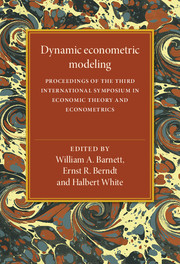 Dynamic Econometric Modeling
Dynamic Econometric Modeling Published online by Cambridge University Press: 03 May 2010
This chapter attempts to give a structural interpretation to the distributed lag of sales on investment at the two–digit level in U.S. manufacturing. It first presents a simple model that captures the various sources of lags and their respective implications. It then estimates the model using both data on investment and sales as well as direct information on the sources of lags. The spirit of the chapter is exploratory; the model is used mainly as a vehicle to construct, present, and interpret the data.
Lags in the response of investment expenditures to sales can be attributed to four main sources. The first is expectations. Investment depends on future sales, which themselves depend on current and past sales. The next two come from technology. One, costs of adjustment, is internal to the firm. The other, delivery lags, is external to the firm. Together they imply that the firm is neither willing nor able to adjust its capital stock completely and instantaneously to movements in sales. The last source is financial. Although the theory describes investment orders, data are about investment expenditures, which are related to orders by a distributed lag. Section 1 presents a model that incorporates these four sources explicitly and shows their respective implications.
Section 2 presents the basic investment and sales characteristics for 13 industries. It estimates a reduced–form relation of investment on sales and the capital stock, showing common patterns and differences across industries.
To save this book to your Kindle, first ensure [email protected] is added to your Approved Personal Document E-mail List under your Personal Document Settings on the Manage Your Content and Devices page of your Amazon account. Then enter the ‘name’ part of your Kindle email address below. Find out more about saving to your Kindle.
Note you can select to save to either the @free.kindle.com or @kindle.com variations. ‘@free.kindle.com’ emails are free but can only be saved to your device when it is connected to wi-fi. ‘@kindle.com’ emails can be delivered even when you are not connected to wi-fi, but note that service fees apply.
Find out more about the Kindle Personal Document Service.
To save content items to your account, please confirm that you agree to abide by our usage policies. If this is the first time you use this feature, you will be asked to authorise Cambridge Core to connect with your account. Find out more about saving content to Dropbox.
To save content items to your account, please confirm that you agree to abide by our usage policies. If this is the first time you use this feature, you will be asked to authorise Cambridge Core to connect with your account. Find out more about saving content to Google Drive.